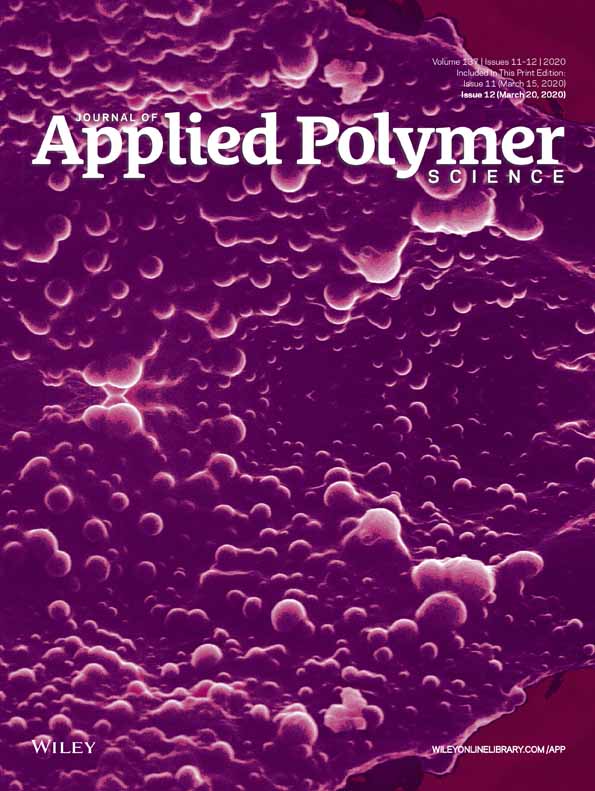Saccharomyces cerevisae microfiltration performance of polycarbonate membranes containing chitosan-based polyelectrolyte complexes
Rayane S. Vale
Polymer Laboratory, Department of Chemistry, Federal University of São Carlos, Via Washington Luís km 235, São Carlos, São Paulo, 13565-905 Brazil
Search for more papers by this authorCorresponding Author
Caio M. Paranhos
Polymer Laboratory, Department of Chemistry, Federal University of São Carlos, Via Washington Luís km 235, São Carlos, São Paulo, 13565-905 Brazil
Correspondence to: C. M. Paranhos (E-mail: [email protected])Search for more papers by this authorRayane S. Vale
Polymer Laboratory, Department of Chemistry, Federal University of São Carlos, Via Washington Luís km 235, São Carlos, São Paulo, 13565-905 Brazil
Search for more papers by this authorCorresponding Author
Caio M. Paranhos
Polymer Laboratory, Department of Chemistry, Federal University of São Carlos, Via Washington Luís km 235, São Carlos, São Paulo, 13565-905 Brazil
Correspondence to: C. M. Paranhos (E-mail: [email protected])Search for more papers by this authorABSTRACT
Polyelectrolyte complexes (PECs) were prepared using chitosan and sulfonated poly(ethylene terephthalate) by the mixture method. Fourier transform infrared spectroscopy, zeta potential, X-ray diffraction, and thermogravimetric analysis were used to characterize the chemical structure, surface charge, crystallinity, and thermal stability of the PECs. To evaluate how PECs affect the water vapor flux and the microfiltration performance, PECs solutions were spread via casting on polycarbonate microporous membranes. The increase in water vapor flux and in the Saccharomyces cerevisae microfiltration performance indicated that the presence of the PECs acts as fixed charges, changing significantly the transport properties of the polycarbonate matrix. © 2019 Wiley Periodicals, Inc. J. Appl. Polym. Sci. 2020, 137, 48483.
REFERENCES
- 1Du, J.; Sun, R.; Zhang, S.; Zhang, L.-F.; Xiong, C.-D.; Peng, Y.-X. Biopolymers. 2005, 78, 1.
- 2Cerchiara, T.; Abruzzo, A.; Parolin, C.; Vitali, B.; Bigucci, F.; Gallucci, M. C.; Nicoletta, F. P.; Luppi, B. Carbohydr. Polym. 2016, 143, 124.
- 3Ji, F.; Li, J.; Qin, Z.; Yang, B.; Zhang, E.; Dong, D.; Wang, J.; Wen, Y.; Tian, L.; Yao, F. Carbohydr. Polym. 2017, 177, 86.
- 4Mocchiutti, P.; Schnell, C. N.; Rossi, G. D.; Peresin, M. S.; Zanuttini, M. A.; Galván, M. V. Carbohydr. Polym. 2016, 150, 89.
- 5Kolman, K.; Nechyporchuk, O.; Persson, M.; Holmberg, K.; Bordes, R. Colloids Surf. A Physicochem. Eng. Asp. 2017, 532, 420.
- 6Yu, L.; Liu, X.; Yuan, W.; Brown, L. J.; Wang, D. Langmuir. 2015, 31, 6351.
- 7Coimbra, P.; Alves, P.; Valente, T. A. M.; Santos, R.; Correia, I. J.; Ferreira, P. Int. J. Biol. Macromol. 2011, 49, 573.
- 8Xu, C.; Xue, S.; Wang, P.; Wu, C.; Wu, Y. Sep. Purif. Technol. 2017, 172, 140.
- 9Ye, C.-C.; Zhao, F.-Y.; Wu, J.-K.; Weng, X.-D.; Zheng, P.-Y.; Mi, Y.-F.; An, Q.-F.; Gao, C.-J. Chem. Eng. J. 2017, 307, 526.
- 10Khulbe, K. C.; Feng, C.; Matsuura, T. J. Appl. Polym. Sci. 2010, 115, 855.
- 11Wang, H.; Wang, W.; Wang, L.; Zhao, B.; Zhang, Z.; Xia, X.; Yang, H.; Xue, Y.; Chang, N. Chem. Eng. J. 2018, 334, 2068.
- 12Ruan, H.; Zheng, Z.; Pan, J.; Gao, C.; Van der Bruggen, B.; Shen, J. J. Membr. Sci. 2018, 550, 427.
- 13Zhang, W.; He, G.; Gao, P.; Chen, G. Sep. Purif. Technol. 2003, 30, 27.
- 14Wavhal, D. S.; Fisher, E. R. J. Membr. Sci. 2002, 209, 255.
- 15Yue, W.-W.; Li, H.-J.; Xiang, T.; Qin, H.; Sun, S.-D.; Zhao, C.-S. J. Membr. Sci. 2013, 446, 79.
- 16Galiano, F.; André Schmidt, S.; Ye, X.; Kumar, R.; Mancuso, R.; Curcio, E.; Gabriele, B.; Hoinkis, J.; Figoli, A. Sep. Purif. Technol. 2018, 194, 149.
- 17Maya, E. M.; Muñoz, D. M.; de la Campa, J. G.; de Abajo, J.; Lozano, Á. E. Desalination. 2006, 199, 188.
- 18Upadhyaya, L.; Qian, X.; Ranil Wickramasinghe, S. Curr. Opin. Chem. Eng. 2018, 20, 13.
- 19Zhao, Q.; Qian, J.-W.; An, Q.-F.; Yang, Q.; Zhang, P. J. Membr. Sci. 2008, 320, 8.
- 20Kulkarni, A. D.; Vanjari, Y. H.; Sancheti, K. H.; Patel, H. M.; Belgamwar, V. S.; Surana, S. J.; Pardeshi, C. V. Artif. Cells, Nanomed. Biotechnol. 2016, 44, 1615.
- 21Stopilha, R. T.; de Lima, C. R. M.; Pereira, M. R.; Fonseca, J. L. C. Colloids Surf. A Physicochem. Eng. Asp. 2016, 489, 27.
- 22Senra, T. D. A.; Khoukh, A.; Desbrières, J. Carbohydr. Polym. 2017, 156, 182.
- 23Rinaudo, M. Prog. Polym. Sci. 2006, 31, 603.
- 24Luo, Y.; Wang, Q. Int. J. Biol. Macromol. 2014, 64, 353.
- 25Wan Ngah, W. S.; Teong, L. C.; Hanafiah, M. A. K. M. Carbohydr. Polym. 2011, 83, 1446.
- 26Kulig, D.; Zimoch-Korzycka, A.; Jarmoluk, A. Meat Sci. 2017, 123, 219.
- 27Paranhos, C. M.; Dahmouche, K.; Zaioncz, S.; Soares, B. G.; Pessan, L. A. J. Polym. Sci. Part B Polym. Phys. 2008, 46, 1390.
- 28Paranhos, C. M.; Soares, B. G.; Machado, J. C.; Windmöller, D.; Pessan, L. A. Eur. Polym. J. 2007, 43, 4882.
- 29Rege, P. R.; Block, L. H. Carbohydr. Res. 1999, 321, 235.
- 30Tanaka, Y. Preparation of ion exchange membranes. In Ion Exchange Membranes, Elsevier: Amsterdam, Netherlands, 2015.
10.1016/B978-0-444-63319-4.00002-X Google Scholar
- 31Canella, K. M. N. d. C.; Garcia, R. B. Quim. Nova. 2001, 24, 13.
- 32dos Santos, J. E.; Soares, J. d. P.; Dockal, E. R.; Campana Filho, S. P.; Cavalheiro, É. T. G. Polímeros. 2003, 13, 242.
10.1590/S0104-14282003000400009 Google Scholar
- 33Vijayakumar, S.; Rajakumar, P. R. Int. Lett. Chem. Phys. Astron. 2013, 4, 58.
10.18052/www.scipress.com/ILCPA.4.58 Google Scholar
- 34Wang, H.; Li, W.; Lu, Y.; Wang, Z. J. Appl. Polym. Sci. 1997, 65, 1445.
- 35Wan, Y.; Creber, K. A.; Peppley, B.; Bui, V. T. Polymer (Guildf). 2003, 44, 1057.
- 36Yin, J.; Dai, Z.; Yan, S.; Cao, T.; Ma, J.; Chen, X. Polym. Int. 2007, 56, 1122.
- 37Ruvolo-Filho, A.; Murakami, M. M. J. Macromol. Sci. Part B. 1998, 37, 627.
- 38Narong, P.; James, A. E. Sep. Purif. Technol. 2006, 49, 149.




